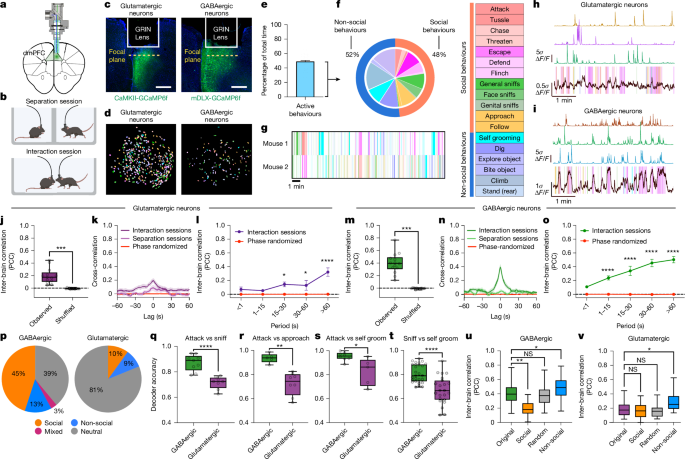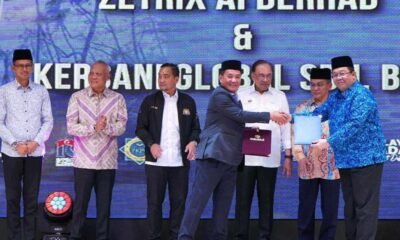AI Research
Inter-brain neural dynamics in biological and artificial intelligence systems

Chen, P. & Hong, W. Neural circuit mechanisms of social behavior. Neuron 98, 16–30 (2018).
Kingsbury, L. & Hong, W. A multi-brain framework for social interaction. Trends Neurosci. 43, 651–666 (2020).
Czeszumski, A. et al. Hyperscanning: a valid method to study neural inter-brain underpinnings of social interaction. Front. Hum. Neurosci. 14, 39 (2020).
Dumas, G. & Fairhurst, M. T. Reciprocity and alignment: quantifying coupling in dynamic interactions. R. Soc. Open Sci. 8, 210138 (2021).
Dumas, G., Lachat, F., Martinerie, J., Nadel, J. & George, N. From social behaviour to brain synchronization: review and perspectives in hyperscanning. IRBM 32, 48–53 (2011).
Hasson, U., Ghazanfar, A. A., Galantucci, B., Garrod, S. & Keysers, C. Brain-to-brain coupling: a mechanism for creating and sharing a social world. Trends Cogn. Sci. 16, 114–121 (2012).
Kinreich, S., Djalovski, A., Kraus, L., Louzoun, Y. & Feldman, R. Brain-to-brain synchrony during naturalistic social interactions. Sci. Rep. 7, 17060 (2017).
Tseng, P.-H., Rajangam, S., Lehew, G., Lebedev, M. A. & Nicolelis, M. A. L. Interbrain cortical synchronization encodes multiple aspects of social interactions in monkey pairs. Sci. Rep. 8, 4699 (2018).
Kingsbury, L. et al. Correlated neural activity and encoding of behavior across brains of socially interacting animals. Cell 178, 429–446 (2019).
Zhang, W. & Yartsev, M. M. Correlated neural activity across the brains of socially interacting bats. Cell 178, 413–428 (2019).
Botvinick, M., Wang, J. X., Dabney, W., Miller, K. J. & Kurth-Nelson, Z. Deep reinforcement learning and its neuroscientific implications. Neuron 107, 603–616 (2020).
Arulkumaran, K., Deisenroth, M. P., Brundage, M. & Bharath, A. A. Deep reinforcement learning: a brief survey. IEEE Signal Process. Mag. 34, 26–38 (2017).
Busoniu, L., Babuska, R. & Schutter, B. D. A comprehensive survey of multiagent reinforcement learning. IEEE Trans. Syst. Man Cybern. C 38, 156–172 (2008).
Zhang, K., Yang, Z. & Başar, T. in Handbook of Reinforcement Learning and Control (eds Vamvoudakis, K. G. et al.) 321–384 (2021).
Yizhar, O. et al. Neocortical excitation/inhibition balance in information processing and social dysfunction. Nature 477, 171–178 (2011).
Murugan, M. et al. Combined social and spatial coding in a descending projection from the prefrontal cortex. Cell 171, 1663–1677 (2017).
Scheggia, D. et al. Somatostatin interneurons in the prefrontal cortex control affective state discrimination in mice. Nat. Neurosci. 23, 47–60 (2020).
Kingsbury, L. et al. Cortical representations of conspecific sex shape social behavior. Neuron 107, 941–953 (2020).
Frost, N. A., Haggart, A. & Sohal, V. S. Dynamic patterns of correlated activity in the prefrontal cortex encode information about social behavior. PLoS Biol. 19, e3001235 (2021).
Monte, O. D. et al. Widespread implementations of interactive social gaze neurons in the primate prefrontal-amygdala networks. Neuron 110, 2183–2197 (2022).
Li, S. W. et al. Frontal neurons driving competitive behaviour and ecology of social groups. Nature 603, 661–666 (2022).
Padilla-Coreano, N., Tye, K. M. & Zelikowsky, M. Dynamic influences on the neural encoding of social valence. Nat. Rev. Neurosci. 23, 535–550 (2022).
Merre, P. L., Ährlund-Richter, S. & Carlén, M. The mouse prefrontal cortex: unity in diversity. Neuron 109, 1925–1944 (2021).
Abdi, H. & Williams, L. J. Partial least squares methods: partial least squares correlation and partial least square regression. Methods Mol. Biol. 930, 549–579 (2012).
Lopes-dos-Santos, V., Ribeiro, S. & Tort, A. B. L. Detecting cell assemblies in large neuronal populations. J Neurosci. Methods 220, 149–166 (2013).
Pereira, T. D. et al. SLEAP: a deep learning system for multi-animal pose tracking. Nat. Methods 19, 486–495 (2022).
Hotelling, H. Relations between two sets of variates. Biometrika 28, 321 (1936).
Liang, E. et al. RLlib: abstractions for distributed reinforcement learning. In Proc. 35th International Conference on Machine Learning 80, 3053–3062 (PMLR, 2018).
Schulman, J., Wolski, F., Dhariwal, P., Radford, A. & Klimov, O. Proximal policy optimization algorithms. Preprint at https://doi.org/10.48550/arxiv.1707.06347 (2017).
Tremblay, R., Lee, S. & Rudy, B. GABAergic interneurons in the neocortex: from cellular properties to circuits. Neuron 91, 260–292 (2016).
Hattori, R., Kuchibhotla, K. V., Froemke, R. C. & Komiyama, T. Functions and dysfunctions of neocortical inhibitory neuron subtypes. Nat. Neurosci. 20, 1199–1208 (2017).
Pinto, L. & Dan, Y. Cell-type-specific activity in prefrontal cortex during goal-directed behavior. Neuron 87, 437–450 (2015).
Dumas, G., Nadel, J., Soussignan, R., Martinerie, J. & Garnero, L. Inter-brain synchronization during social interaction. PLoS ONE 5, e12166 (2010).
Barraza, P., Pérez, A. & Rodríguez, E. Brain-to-brain coupling in the gamma-band as a marker of shared intentionality. Front. Hum. Neurosci. 14, 295 (2020).
Semedo, J. D., Zandvakili, A., Machens, C. K., Yu, B. M. & Kohn, A. Cortical areas interact through a communication subspace. Neuron 102, 249–259 (2019).
Fakhar, K. & Hilgetag, C. C. Systematic perturbation of an artificial neural network: a step towards quantifying causal contributions in the brain. PLoS Comput. Biol. 18, e1010250 (2022).
Cowley, B. R. et al. Mapping model units to visual neurons reveals population code for social behaviour. Nature 629, 1100–1108 (2024).
Kao, J. C. Considerations in using recurrent neural networks to probe neural dynamics. J. Neurophysiol. 122, 2504–2521 (2019).
Vong, L. et al. Leptin action on GABAergic neurons prevents obesity and reduces inhibitory tone to POMC neurons. Neuron 71, 142–154 (2011).
Dimidschstein, J. et al. A viral strategy for targeting and manipulating interneurons across vertebrate species. Nat. Neurosci. 19, 1743–1749 (2016).
Pnevmatikakis, E. A. & Giovannucci, A. NoRMCorre: an online algorithm for piecewise rigid motion correction of calcium imaging data. J. Neurosci. Methods 291, 83–94 (2017).
Zhou, P. et al. Efficient and accurate extraction of in vivo calcium signals from microendoscopic video data. eLife 7, e28728 (2018).
Zhang, M., Wu, Y. E., Jiang, M. & Hong, W. Cortical regulation of helping behaviour towards others in pain. Nature 626, 136–144 (2024).
Wu, Y. E. et al. Neural control of affiliative touch in prosocial interaction. Nature 599, 262–267 (2021).
Adhikari, R. & Agrawal, R. K. An Introductory Study on Time Series Modeling and Forecasting (Lambert Academic Publishing, 2013).
Sheintuch, L. et al. Tracking the same neurons across multiple days in Ca2+ imaging data. Cell Rep. 21, 1102–1115 (2017).
Musall, S., Kaufman, M. T., Juavinett, A. L., Gluf, S. & Churchland, A. K. Single-trial neural dynamics are dominated by richly varied movements. Nat. Neurosci. 22, 1677–1686 (2019).
Lerer, A. & Peysakhovich, A. Maintaining cooperation in complex social dilemmas using deep reinforcement learning. Preprint at https://doi.org/10.48550/arxiv.1707.01068 (2017).
Foerster, J. N. et al. Learning with opponent-learning awareness. In Proc. 17th International Conference on Autonomous Agents and MultiAgent Systems 122–130 (ACM, 2018).
Lu, C., Willi, T., de Witt, C. S. & Foerster, J. Model-free opponent shaping. In Proc. 39th International Conference on Machine Learning Vol. 162, 14398–14411 (PMLR, 2022).
Zhou, J. L., Hong, W. & Kao, J. C. Reciprocal reward influence encourages cooperation from self-interested agents. In Proc. 38th Conference on Neural Information Processing Systems 59491–59512 (Curran Associates, 2024).
Agapiou, J. P. et al. Melting Pot 2.0. Preprint at https://doi.org/10.48550/arxiv.2211.13746 (2022).
Espeholt, L. et al. IMPALA: scalable distributed deep-RL with importance weighted actor–learner architectures. In Proc. 35th International Conference on Machine Learning (PMLR, 2018).
AI Research
Gachon University establishes AI·Computing Research Institute – 조선일보
AI Research
Tech war: Tencent pushes adoption of Chinese AI chips as mainland cuts reliance on Nvidia

Tencent has “fully adapted to mainstream domestic chips” and “participates in the open-source community”, Tencent Cloud president Qiu Yuepeng said at the company’s annual Global Digital Ecosystem Summit on Tuesday.
AI Research
Using AI for homework and social media bans in BBC survey results – BBC
-

 Business3 weeks ago
Business3 weeks agoThe Guardian view on Trump and the Fed: independence is no substitute for accountability | Editorial
-
Tools & Platforms1 month ago
Building Trust in Military AI Starts with Opening the Black Box – War on the Rocks
-

 Ethics & Policy2 months ago
Ethics & Policy2 months agoSDAIA Supports Saudi Arabia’s Leadership in Shaping Global AI Ethics, Policy, and Research – وكالة الأنباء السعودية
-

 Events & Conferences4 months ago
Events & Conferences4 months agoJourney to 1000 models: Scaling Instagram’s recommendation system
-

 Jobs & Careers3 months ago
Jobs & Careers3 months agoMumbai-based Perplexity Alternative Has 60k+ Users Without Funding
-

 Podcasts & Talks2 months ago
Podcasts & Talks2 months agoHappy 4th of July! 🎆 Made with Veo 3 in Gemini
-

 Education3 months ago
Education3 months agoVEX Robotics launches AI-powered classroom robotics system
-

 Education2 months ago
Education2 months agoMacron says UK and France have duty to tackle illegal migration ‘with humanity, solidarity and firmness’ – UK politics live | Politics
-

 Podcasts & Talks2 months ago
Podcasts & Talks2 months agoOpenAI 🤝 @teamganassi
-

 Funding & Business3 months ago
Funding & Business3 months agoKayak and Expedia race to build AI travel agents that turn social posts into itineraries













